
Hexatonic Scales: Guitar Theory Guide
A Lesson on the Four Most Common Hexatonic Scales Used on Guitar
Hexatonic Scales have 6 Notes
Hex = Six and Tonic= Comprised of Tones or Notes. When we say a scale is Hexatonic, on guitar or any other instrument, we are simply saying the scale has six, and only six different notes.
A five note scale is called a Pentatonic Scale, a seven note scale can be called a Heptatonic Scale,and an eight note scale would be Octatonic.
So any scale with exactly six notes is Hexatonic by definition, but they are not all created equal! This article discusses the construction and usages of the 4 most important hexatonic scales for Rock, Blues, and Metal Guitar: the Hexatonic Major scale, the Hexatonic Minor scale, the Major Blues scale, and most importantly the Blues Scale, which is both theoretically and historically the underpinnings of all the guitar styles which have kicked any amount of ass since the 20th century.
Please note: This article will not discuss the modern Jazz practice of constructing Hexatonic scales more or less on the fly
by stacking triads. I am also not including the Whole Tone scale. It has six notes but is a very Jazz specific a sound on the guitar.
Why use Hexatonic Scales?
One huge reason is rhythm.
Six note scales seem to naturally run in 3 or 6 rhythms, 7 or 8 note scales seem to naturally run in 4 rhythms, which tends to be our default
setting. But being able to subdivide beats into 3 or six notes adds an huge and essential dimension to our playing.
The Hexatonic Major scale also has a rather specific advantage when harmonizing guitar parts, which will be discussed below.
The Hexatonic Minor Scale on Guitar
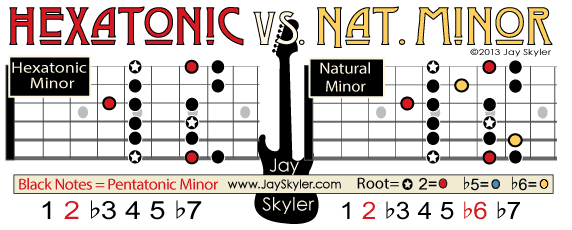
This six note scale minor scale can be thought of as 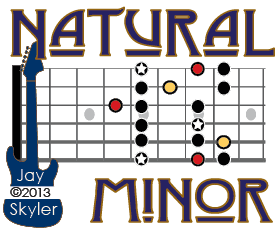 Natural Minor with no 6th scale degree, or as the Pentatonic Minor Scale plus a natural second scale degree.
Natural Minor with no 6th scale degree, or as the Pentatonic Minor Scale plus a natural second scale degree.
It is not the only six note minor scale, The Blues Scale
is also minor and has six notes. You could also construct other 6 note scales that were also Minor (remember you must have a
official
name (like Blues).
Important! This is not a mode of the Hexatonic Major scale!
Some Uses of the Hexatonic Minor Scale on Guitar
Hexatonic Minor Scale
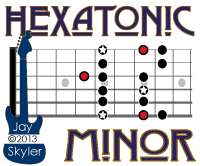
- Quality / Family:
- Minor
- Also Classified As:
- Hexatonic
- Notes (with a root of A):
A B C D E G - Scale Degrees:
1 2 3 4 57 - Alternative Names:
- No Common Alternative Names
- Important Modes:
- None
- IMPORTANT!
- This is not a mode of Hexatonic Major!
To Change the Rhythmic Feel of Natural Minor or Dorian
The Hexatonic Minor scale is a subset of both the Natural Minor scale and the Dorian Minor scale (AKA Dorian Mode), and can therefore be safely switched to whenever you are playing one of them (assuming you know how to use them.) Dropping the sixth scale degree gives us a six note scale, which will have a different rhythmic feel especially when playing fast.
To Make Blues Less Aggressive, More Melodic
This is a move I've heard Hendrix use, so it is automatically cool. The idea is to play blues in the low register, and then to switch to Minor Hexatonic only in the high pitched notes of a passage or phrase. We keep the feel of a six note scale, yet we create an instant melodic contrast by trading the flatted fifth scale degree for the second (same notes as the 9 btw). This is surprisingly easy (in guitar terms anyway) to implement.
Play the Blues in its root position box, and add the third finger note (the two) on the high E string. See the picture below.
When the IV- Chord in a Minor progression has been changed to a Major or Dominant 7th Chord
In a Minor chord progression, the fourth chord in the key is ordinarily a minor triad or a minor 7th chord. Switching the V-7 chord to a dominant seventh chord to resolve is how we get Harmonic Minor and is the rule rather than the exception. But any or all of the chords may be changed to other chord qualities (usually Major or Dominant 7th chords).
One common songwriting move is to change every single chord in a Minor chord progression to Major chords. Another is to change all the chords but the I- or root chord to Major chords.
Whatever the reason, if the fourth chord in a Minor key (which is usually minor) becomes Major or Dominant 7, Hexatonic minor can be used to avoid the clashing note that will result when staying in Natural Minor when the IV chord comes around in the progression (i.e. the flatted sixth scale degree becomes a natural six when the IV- chord is changed to a Major chord (IV)). Hexatonic Minor has no sixth so avoids the issue altogether.
The Blues Scale
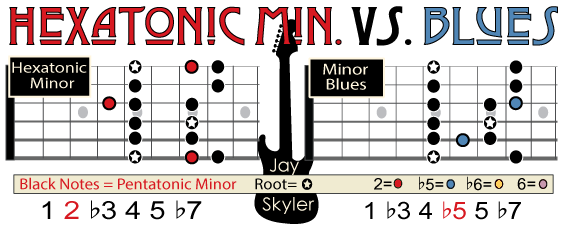
The Blues Scale
= The Minor Blues Scale
Since it contains a flatted third and a natural fifth, the Minor blues Scale is, by definition a Minor scale. This is the scale you see in the Guitar Neck Scale chart on this page, which simply has the heading "Blues." You can refer to it as the Blues Scale or as the Minor Blues Scale and other musicians will understand. They mean the same thing, and since its been the most important scale in popular music for about a century now, anyone with even the faintest knowledge of theory will be familiar with it.
(Minor) Blues Scale Usage
If you play Rock, Blues, or Metal, this is the single most important scale to know; this is both historically and theoretically the foundation of all of three (and their sub-genres). Don't even bother with the other scales until you have a good command of this one.
If a song is in the key of A minor, we can play the A blues scale straight through the whole solo. If a song is in the key of A Major, we can play the A blues scale straight through the whole solo. If a song is in the key of A whatever, we can play the A blues scale straight through the whole solo. Won't some notes clash in some situations? Yes. Welcome to America.
The Hexatonic Blues Scale vs. The Pentatonic Blues Scale
The Pentatonic Blues Scale is far less useful than the hexatonic Blues Scale for a very simple reason: It doesn't exist. Its a completely incorrect name for the Blues Scale, which has six notes, and is therefore hexatonic. There is the Pentatonic Minor scale which can be used as a "kind-of" simplified Blues Scale (discussed below), but its incorrect to call that the Blues scale, because the Blues Scale has an additional note, i.e. the
The Pentatonic Minor Scaleis one note short of this, and loses a lot of the blues scale's ability to function over pretty much any kind of progression (if you have the skills).
Keep in mind, most music books are written by music professors, and they play Jazz or Classical, so it gets down-played. But it is absolutely essential.
Hexatonic Major Scale
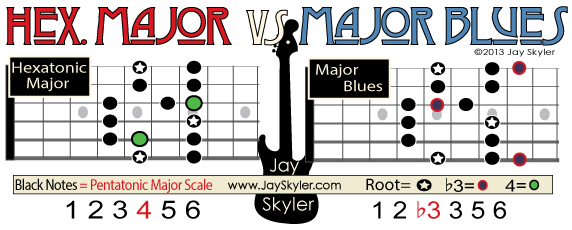
The Hexatonic Major Scale is basically the Major Scale minus the 7th scale degree.
You can also think of it as the Pentatonic Major scale plus the 4th scale degree. The Pentatonic Major scale removes both notes that are traditionally considered dissonant from the Major Scale: the 4 and the 7, leaving us with scales degrees
The Hexatonic Major scale doesn't go quite so far, it keeps the fourth scale degree and only drops the seventh.
You could also see this as removing notes from the Dominant 7th scale, as it is a subset of both the Major Scale (called Ionian Mode by the Catholic Church) and the Dominant 7th Scale (called Mixolydian Mode by the Catholic Church).
Due to the naming conventions, we must call it Major, as you cannot have a Dominant 7th chord or scale without a
Hexatonic Major Scale Modes
There are no widely used modes of the Hexatonic Major Scale.
Important! This is not a Mode of the Hexatonic Minor Scale!Major Blues Scale
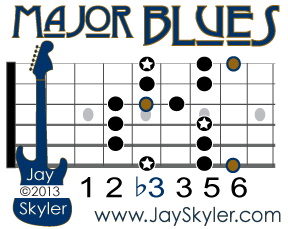
Unlike the Major or Minor scale, which have functional (meaning they sound good at least sometimes) modes built on every note in the scale, the Blues Scale only has one functional mode, the Major Blues scale. The Major Blues scale is built on the flatted third scale degree (
As a quick reminder, the Major Blues and Minor Blues are modes of one another, the Hexatonic Minor and Hexatonic Major are not related modally, they are just the most common Minor or Major hexatonic scales outside the Minor Blues scale and Major Blues scale.
The Major Blues Scale, being hexatonic, has six notes:You can think of it as the Pentatonic Major Scale plus a flatted third
The Minor Blues Scale, not the Major Blues, is Standard
The Minor Blues scale is the far more commonly used scale of the two, so as in the norm in music, it gets shortened to The Blues Scale.
Its just like with chords. If I asked you to play a G chord you would (I hope) play a G Major chord. Since the most common type of chord is major we can shorten the name of G Major chord to just G chord. So when we say the Blues Scale
we are just using a shortened name for the Minor Blues Scale. If we want to refer to the Major Blues scale we must say Major Blues Scale
.
The articles and diagrams on this site are provided free for personal use, without ads, and no personal information is collected or sold. If you have found this information valuable, please consider making a donation of any amount at https://paypal.me/JaySkylerGuitar Thanks! Jay Skyler
The charts and articles on this site are 100% my original copywrited writing and artwork. They may not be reproduced or modified without express written permission from Jay Skyler. They may not be linked to any site except www.JaySkyler.com. I file copyright claims with any platform they appear on if these terms are violated.